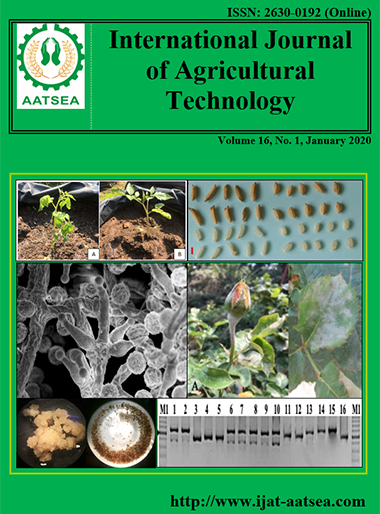Blast resistance evaluation and genetic inheritance of gene controlling leaf blast resistance in Dawk Pa-yawm Rai variety (GS23774)
Main Article Content
Abstract
The landrace rice Dawk Pa-yawm Rai variety was highly resistant to 18 blast isolates, moderately resistant to 5 and susceptible to 2 blast isolates. Therefore, Dawk Pa-yawm Rai variety was broad-spectrum resistance to many blast isolates and can be used as genetic resource in breeding programs for blast disease resistance. The genetic inheritance of blast resistance in F2 population was identified. Seven hundred and thirty F2 plants from a cross between KDML105 (recipient) and Dawk Pa-yawm Rai (donor) were generated. The disease assessment revealed 524 F2 plants were resistant and 206 F2 plants were susceptible. The segregation of resistance and susceptible phenotypes showed a goodness of fit to the ratio 3:1 (R:S). The result found is important factor and useful in mapping of blast resistant gene in Dawk Pa-yawm Rai variety.
Article Details

This work is licensed under a Creative Commons Attribution-NonCommercial-NoDerivatives 4.0 International License.
References
Mekwatanakarn, P., Cobelli, P., Nalumpang Nernplub, A., Rithmontree, T., Ketsuwan, K., Klinmanee, C. and Deerith, S. T. (2007). Determination of pathotype diversity of rice blast fungal population in Thailand. Thai Rice Research Journal, 1:52-64.
Ou, S. H. (1985). Rice Diseases. Second ed. Commonwealth Agricultural Bureau, Surry, United Kingdom, pp. 109-201.
Parinthawong, N., Tansian, P. and Sreewongchai, T. (2015). Genetic mapping of leaf blast resistance gene in landrace rice cultivar ‘GS19769’. Maejo International Journal of Science and Technology, 9:278-287.
Phaitreejit, K., Srikaew, E., Jantasuriyarat, C., Sriwongchai, T. and Kate-ngam, S. (2011). Screening Thai landrace rice for blast resistance gene Pi9, Pi36, Pigm(t) using DNA markers. Thai Journal of Genetics, 4:52-62.
Rice Department (2011). Rice knowledge bank: Khao Dawk Mali 105. Retrieved from http://www.ricethailand.go.th/web/.
Roumen, E., Levy, M. and Notteghem, J. L. (1997). Characterization of the European pathogen population of Magnaporthe grisea by DNA finger printing and pathotype analysis. European Journal of Plant Pathology, 103:363-371.
Salih, A., Sreewongchai, T., Sripichitt, P. and Parinthawong, N. (2013). Identification of blast resistant varieties from landrace, improved and wild species of rice. Kasetsart Journal (Natural Science), 47:1-7.
Sirithunya, P., Sreewongchai, T., Sriprakhon, S., Toojinda, T., Pimpisithavorn, S., Kosawang, C. and Smitamana, P. (2008). Assessment of genetic diversity in Thai isolates of Pyricularia grisea by random amplification of polymorphic DNA. Journal of Phytopathology, 156:196-204.
Sreewongchai, T., Sriprakhon, S., Wongsaprom, C., Vanavichit, A., Toojinda, T., Tharreau, D. and Sirithunya, P. (2009). Genetic mapping of Magnaporthe grisea avirulence gene corresponding to leaf and panicle blast resistant QTLs in Jao Hom Nin rice cultivar. Journal of Phytopathology, 157:338-343.


